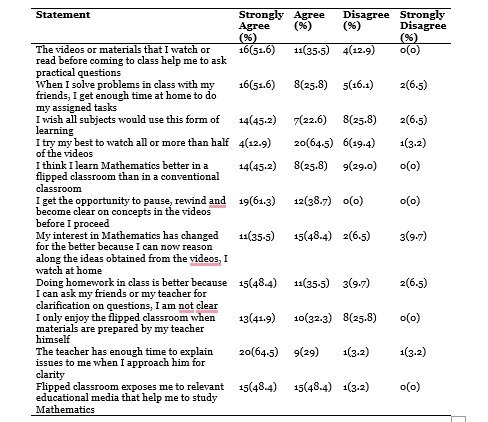Exploring Junior High Students’ Perceptions and Barriers in Implementing the Flipped Classroom Model for Mathematics in Ghana
Main Article Content
Abstract
Purpose – The flipped classroom model is increasingly recognized as an innovative approach to enhance student engagement and understanding in mathematics education. However, its implementation and effectiveness in low-resource settings, such as Ghana, remain underexplored. This study investigates junior high school students’ perceptions of and challenges with the flipped classroom model in the context of mathematics instruction.
Methodology – A descriptive survey design was employed involving 31 junior high school students in Ghana. Data were collected using a structured questionnaire that assessed students’ experiences, perceptions, and barriers associated with the flipped learning approach.
Findings – The results showed generally positive perceptions of the model. A total of 61.3% of students agreed that pre-class videos enhanced conceptual understanding, while 83.9% reported increased engagement during in-class activities. Nonetheless, substantial challenges were identified, including data exhaustion (51.6%) and lack of access to personal digital devices (58.1%), which limited students’ ability to fully engage with pre-class materials.
Novelty – This study offers a unique contribution by examining the flipped classroom model in a low-income educational context. Unlike previous research focused on high-resource environments, this study addresses the practical realities of digital inequality and provides learner-centered insights into adapting flipped learning in under-resourced settings.
Significance – The findings highlight the potential of flipped learning in improving mathematics instruction, while also underscoring the infrastructural and technological barriers that must be addressed. These insights can guide educators and policymakers in designing inclusive, context-appropriate strategies for effective technology integration in education.
Article Details
References
Aidoo, B., Mensah, D. K. D., & Armah, J. K. (2022). The impact of flipped learning on preservice teachers’ learning outcomes and perceptions. Journal of Science Education and Technology, 31(4), 625–640. https://doi.org/10.1007/s10956-022-09941-6
Akuffo, B., Okae-Adjei, S., & Dzisi, S. (2019). Flipped learning as an alternative learning pathway for effective and efficient technical and vocational education and training (TVET): Evidence from Koforidua Technical University – Ghana. [Journal Name Missing], 9, 215.
Aldaka, L. (2020). Student engagement in blended learning environments: A review of the literature. Educational Review, 72(6), 659–677.
Bergmann, J., & Sams, A. (2012). Flip your classroom: Reach every student in every class every day. International Society for Technology in Education.
Bishop, J. L., & Verleger, M. A. (2013). The flipped classroom: A survey of the research. In Proceedings of the ASEE Annual Conference & Exposition (Vol. 30, No. 1, pp. 1–18).
Boateng, W., Twum, D., & Asare, B. (2022). The role of the flipped classroom in developing students’ problem-solving skills. International Journal of Educational Technology, 9(1), 42–58.
Cabı, E. (2018). The impact of the flipped classroom model on students’ academic achievement. International Review of Research in Open and Distance Learning, 19(3), 202–221.
Cevikbas, M., & Argun, Z. (2017). The effect of flipped learning on students’ active participation and performance. Educational Technology & Society, 20(1), 152–162.
Chen, F., Wang, T., & Chen, Y. (2014). Exploring students’ engagement in flipped learning. Computers & Education, 83, 191–201.
Cukurbasi, B. (2022). The impact of instructional videos on flipped learning effectiveness. Turkish Online Journal of Distance Education, 23(1), 90–104.
Drozdikova-Zaripova, A. R., & Sabirova, E. G. (2020). Usage of digital educational resources in teaching students with application of 'flipped classroom' technology. Contemporary Educational Technology, 12(2).
Ekmekçi, E. (2017). The flipped writing classroom in Turkish EFL context: A comparative study on a new model. Turkish Online Journal of Distance Education, 18(2), 151–167.
Garcia-Ponce, E., & Mora-Pablo, I. (2020). Student perceptions of flipped instruction in an English as a foreign language classroom. International Journal of Instruction, 13(1), 117–130.
González-Gómez, D., Jeong, J. S., Airado Rodríguez, D., & Cañada-Cañada, F. (2016). Performance and perception in the flipped learning model: An initial approach to evaluate the effectiveness of a new teaching methodology in a general science classroom. Journal of Science Education and Technology, 25, 450–459.
Kaya, G., & Yildirim, T. (2022). Enhancing students’ understanding of science through flipped classrooms. Journal of Science Education and Technology, 31(3), 450–463.
Lee, J., & Choi, H. (2019). The flipped classroom approach in higher education: A meta-analysis. Educational Research Review, 28, 100281. https://doi.org/10.1016/j.edurev.2019.05.001
Lo, C. K., & Hew, K. F. (2017). A critical review of flipped classroom challenges in K-12 education: Possible solutions and recommendations for future research. Research and Practice in Technology Enhanced Learning, 12, 1–22.
Mensah, P. C., Yeboah, A., & Adom, D. (2017). Flipped classroom model as an instructional tool for effective teaching and learning of leatherwork. American Scientific Research Journal for Engineering, Technology, and Sciences, 30(1), 195–212.
Merisi, R., Oteng, P., & Kusi, B. (2022). The role of student-centered learning in flipped classrooms. Journal of Educational Practice, 13(2), 112–128.
Oppong, C., Asare, K., & Nyarko, E. (2022). Flipped learning and pre-service teacher education: A Ghanaian perspective. African Journal of Teacher Education, 11(2), 95–112.
Quansah, F., Donkoh, S., & Osei, M. A. (2018). Using flipped classroom approach to assist pupils to understand the concept of density. International Journal of Multidisciplinary Education and Research, 3(6), 13–18.
Schwichow, M., Croker, S., Zimmermann, B., Höffler, T. N., & Fischer, F. (2022). The flipped classroom and self-autonomy in learning. Educational Psychology Review, 34(3), 765–789.
Sointu, E., Kaarakainen, M. T., Tondeur, J., & Kankaanranta, M. (2022). Students' perceptions of flipped instruction in higher education. Computers & Education, 179, 104431. https://doi.org/10.1016/j.compedu.2021.104431
Steen-Utheim, A., & Foldnes, N. (2018). The flipped classroom and student engagement. Active Learning in Higher Education, 19(1), 43–53. https://doi.org/10.1177/1469787417698135
Van Niekerk, M., & Delport, M. (2022). Evolving flipped classroom design in a cost/management accounting module in a rural South African context. Accounting Education, 31(5), 567–595.
Yeboah, R., Ampadu, E., Ahwireng, D., & Okrah, A. (2020). Knowledge and usage of flipped classroom instructional strategy: The views of Ghanaian teachers. Journal of Education and Learning, 9(3), 57–65.
